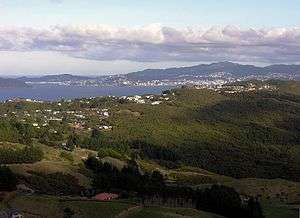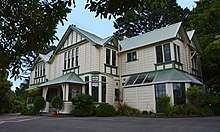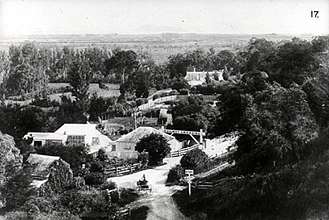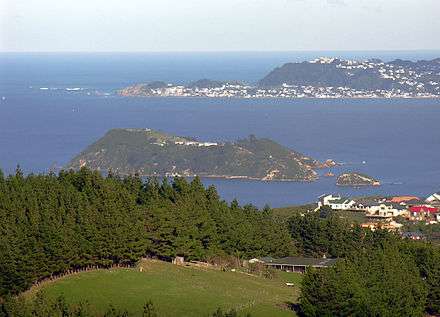Normandale, New Zealand
Normandale is a semi-rural suburb of Lower Hutt City, New Zealand, on the western hills of the Hutt Valley. It consists of two main roads – Normandale Road and Miromiro Road – and the hills between, and is a five-minute drive from the Lower Hutt city centre.[2]
Normandale | |
|---|---|
Suburb | |
 View toward Wellington from the top of Normandale Road | |
| Country | New Zealand |
| Region | Wellington Region |
| Local authority | Lower Hutt City |
| Established | 1901 |
| Area | |
| • Land | 265 ha (655 acres) |
| Population (2013[1]) | |
| • Total | 2,052 |
| Belmont Regional Park | Tirohanga | |
| Maungaraki |
|
Harbour View |
| Alicetown | Melling |
Normandale contains historic woodland reserve Jubilee Park and part of Belmont Regional Park, Wellington's largest Regional Park. It also has many other smaller sections of native bush reserve, so native birds are very common; since 2019 Kiwibank has funded the suburb to suppress bird-killing predators as part of New Zealand's Predator Free project.[3] Normandale is home to a primary school,[4] a kindergarten,[5] a church,[6] a cattery,[7] and a dog boarding kennel,[8] and is otherwise entirely residential. As an older suburb made up entirely of narrow and steep hills, it is dominated by trees.[9]
Geography
Normandale is defined by the area bordered by its two main roads: Normandale Road, starting with the bridge from Alicetown over State Highway 2 / Western Hutt Road and the Melling railway line; and Miromiro Road, which branches off after the bridge. Normandale Road is almost 4.5 kilometers long, whose top few kilometres, at around 200m altitude, serves small farms and lifestyle blocks. It connects north to Sweetacres Drive, Belmont. From the top of Miromiro Road, Dowse Drive connects upward to Normandale's pair suburb Maungaraki, with Poto Road connecting back down to Normandale Road in the opposite direction. The other connecting roads meet Normandale Road: Pokohiwi Road to Pekanga Road in the middle, and Cottle Park Drive and Stratton Street at the upper end bordering Belmont Regional Park.
Jubilee Park

Jubilee Park opened in 1940 to commemorate Wellington's centenary (and the 50th anniversary of Lower Hutt a year later). Mostly consisting of native bush (and the birds who live there), it also includes sites of houses built in the 1890s, a replica pioneer hut with the original chimney, heritage plantings, picnic areas, bush walks, three lawns, and a calisthenics station.[2]
Jubilee Park contains Hutt Minoh Friendship House, a Heritage New Zealand category 1 building. Originally named Norbury, it was built in 1904 by Lower Hutt's first mayor William Fitzherbert, to house his daughter Alice and her husband George William von Zedlitz, Victoria University's first professor of modern languages.[10] It was acquired by the City Council in 1945 to house the park caretaker. Today it is used to promote Japanese culture and Lower Hutt's link with its sister city Minoh, Osaka, whose mayor funded its restoration.[2] It includes New Zealand's first kyūdō dojo.[11]
History

Old Coach Road
Māori used two major routes between Porirua Harbour and Wellington Harbour. One of these, called the Old Coach Road by the Pākehā settlers, ran from the Pauatahanui arm of Porirua Harbour south over the hills, exiting through what is now Normandale, into the Hutt Valley. It was a proposed road connection between the two harbours in the 1850s, and was used by coaches until the mid 1880s when it was abandoned in preference to the Haywards Hill Road. Today Old Coach Road is part of the track system in Belmont Regional Park, and the section between the sealed Stratton Street end and Belmont Road junction is a Heritage New Zealand category 2 area.[12]
Founding and development of the suburb
Normandale was founded in 1901 under the village settlement scheme of the Liberal Government, New Zealand's first political party government, along with its westerly neighbours Maungaraki and Korokoro.[2] It was named after Ann Normandale, mother-in-law of Richard Seddon. It was initially part of Hutt County, and became a part of Lower Hutt City on 6 October 1957.[13]
Substantial development took place during the 1960s and 1970s. The population was stable between 1996 and 2013, with few new dwellings and a decline in the average number of residents per dwelling.[1]
Education
Normandale School is a co-educational state primary school for Year 1 to 6 students,[14][15] with a roll of 190 as of March 2020.[16]
Views


References
- "2013 usual residents". Hutt City Council. Retrieved 20 July 2019.
- "Families flock to handy Normandale". The Dominion Post. 10 May 2012. Retrieved 26 November 2017.
- "Ten more Kiwibank Predator Free Communities announced". Predator Free New Zealand. 10 June 2019. Retrieved 20 July 2019.
- "Normandale School". Retrieved 26 November 2017.
- "Normandale Playcenter". Wellington Playcenter Association. Retrieved 26 November 2017.
- "St Aidan's on the Hill Normandale/Maungaraki". Hutt City Uniting Congregations. Retrieved 26 November 2017.
- "Hillcrest Cat Motel". Retrieved 20 July 2019.
- "Waglands Dogs' Holiday Retreat". 2011. Retrieved 26 November 2017.
- "Normandale Residents Association". Retrieved 20 July 2019.
- "About: Venue". Hutt Minoh Friendship House Trust. Retrieved 26 November 2017.
- Sue Lytollis (16 October 2015). "NZ's first public Kyudo Dojo here at Minoh House". Hutt Minoh Friendship House Trust. Retrieved 26 November 2017.
- Boffa Miskell (April 2012). "Hutt Landscape Study 2012" (PDF). Hutt City Council. p. 52. Retrieved 13 Feb 2019.
- "Normandale marks anniversary". Petone Herald. Archived from the original on 15 October 2008. Retrieved 26 November 2017.
- "Normandale School Official School Website". normandale.school.nz.
- "Normandale School Education Review Office Report". ero.govt.nz. Education Review Office.
- "Normandale School Ministry of Education School Profile". educationcounts.govt.nz. Ministry of Education.